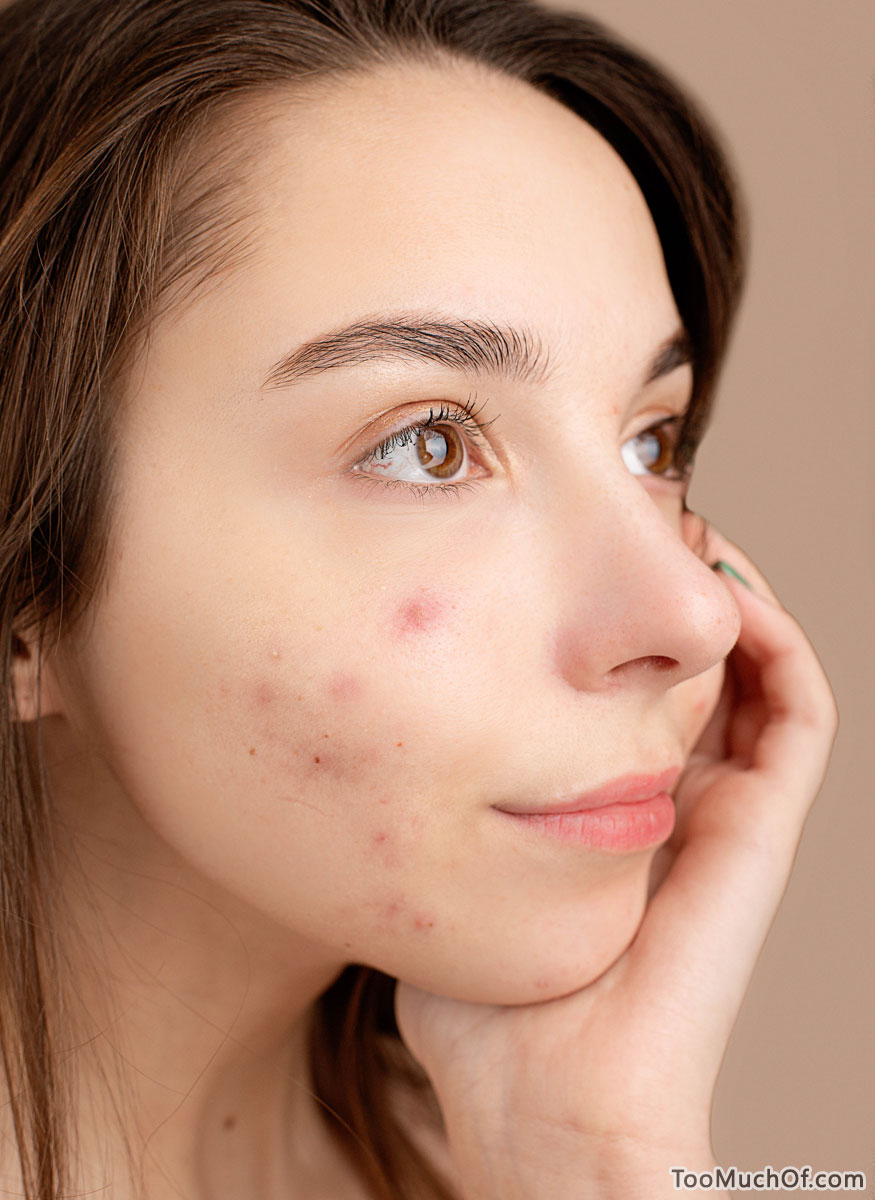Acne is a common skin condition that occurs when hair follicles become clogged with oil, dead skin cells, and bacteria. It primarily affects areas of the body with a high density of oil glands, such as the face, chest, back, and shoulders.
Acne can manifest in various forms
 Comedones – Non-inflammatory acne lesions that appear as either blackheads or whiteheads. Blackheads occur when the pore is partially blocked, allowing the trapped material to oxidize and turn black. Whiteheads occur when the pore is completely blocked, trapping the material beneath the skin’s surface.
Comedones – Non-inflammatory acne lesions that appear as either blackheads or whiteheads. Blackheads occur when the pore is partially blocked, allowing the trapped material to oxidize and turn black. Whiteheads occur when the pore is completely blocked, trapping the material beneath the skin’s surface.
Papules – Small, red, raised bumps on the skin that are typically tender to the touch. Papules occur when the walls of the hair follicles break down due to inflammation.
Pustules: Similar to papules, but with a white or yellowish center filled with pus. Pustules are a result of inflammation and bacterial infection.
Nodules – Large, painful, solid bumps that are deep within the skin. Nodules develop when clogged pores become further inflamed, causing a more severe and prolonged immune response.
Cysts – Deep, pus-filled lumps that are often painful. Cysts are the most severe form of acne and can lead to scarring.
Acne is influenced by a combination of factors
- Excess oil production (sebum) by the skin’s oil glands.
- Accumulation of dead skin cells, which can clog the hair follicles.
- Bacterial overgrowth, primarily by Propionibacterium acnes, which thrives in the clogged follicles.
- Inflammation is triggered by the immune response to the bacterial presence.
- Hormonal changes, such as those that occur during puberty, menstrual cycles, or hormonal disorders, can increase oil production and contribute to acne.
- Other factors, including genetics, stress, certain medications, and skincare or cosmetic products, can also play a role in acne development.
Conventional treatment options for acne vary depending on the severity and type of acne lesions. They may include over-the-counter topical treatments (e.g., benzoyl peroxide or salicylic acid), prescription medications (e.g., topical or oral antibiotics, retinoids), hormonal therapy, or other medical procedures. It’s advisable to consult with a dermatologist for an accurate diagnosis and personalized treatment plan.
Acne is a complex skin condition
 The condition is influenced by various factors, including hormones, genetics, and lifestyle choices. While the exact causes of acne are not fully understood in some situations, there is evidence to suggest that certain dietary factors, such as dairy, sugars, and estrogen, can potentially contribute to acne development or exacerbation in some individuals. However, it’s important to note that the impact of these factors can vary from person to person.
The condition is influenced by various factors, including hormones, genetics, and lifestyle choices. While the exact causes of acne are not fully understood in some situations, there is evidence to suggest that certain dietary factors, such as dairy, sugars, and estrogen, can potentially contribute to acne development or exacerbation in some individuals. However, it’s important to note that the impact of these factors can vary from person to person.
Dairy. Some studies have suggested a possible link between dairy consumption and acne. It is believed that the hormones present in milk, particularly the naturally occurring hormones and growth factors, may potentially stimulate the production of sebum (skin oil) and promote acne formation. Additionally, milk proteins, such as casein and whey, might trigger an inflammatory response in some individuals. However, more research is needed to establish a definitive causal relationship between dairy intake and acne.
Sugars. High-glycemic-index foods, including sugary and processed foods, can lead to increased blood sugar levels and stimulate the release of insulin. Elevated insulin levels may trigger an increase in sebum production and inflammation, both of which can contribute to acne development. Consuming a diet high in added sugars and refined carbohydrates may potentially worsen acne symptoms in certain individuals.
Estrogen. Hormonal fluctuations, particularly changes in androgen (male hormone) levels, play a significant role in acne development. Estrogen, a female hormone, can help regulate sebum production and potentially improve acne symptoms. However, hormonal imbalances or fluctuations, including excess estrogen or estrogen dominance, can also contribute to acne breakouts in some individuals. This is particularly evident during certain stages, such as puberty, menstrual cycles, or hormonal disorders.
While these factors may contribute to acne for some people, it’s important to note that everyone’s skin is unique, and different individuals may respond differently to dietary and hormonal influences.
The association between full-fat dairy and acne
 The association between full-fat dairy and acne is a topic of debate and ongoing research. Some studies have suggested that hormones present in dairy, including estrogen and androgens, could potentially contribute to acne development. However, the evidence is not conclusive, and more research is needed to establish a direct causal relationship.
The association between full-fat dairy and acne is a topic of debate and ongoing research. Some studies have suggested that hormones present in dairy, including estrogen and androgens, could potentially contribute to acne development. However, the evidence is not conclusive, and more research is needed to establish a direct causal relationship.
Full-fat dairy products, such as milk and cheese, contain natural hormones that are naturally present in cow’s milk. These hormones are intended to promote growth and development in calves. When humans consume dairy products, these hormones can potentially affect the hormonal balance in our bodies.
Estrogen, in particular, is present in small amounts in dairy products, including full-fat milk. Excessive levels of estrogen or hormonal imbalances can influence the production of sebum, a naturally occurring oil in the skin. Increased sebum production can contribute to the development of acne.
It’s worth noting that the impact of dairy consumption on acne can vary from person to person. Some individuals may be more sensitive to the hormonal effects of dairy, while others may not experience any noticeable effects. Additionally, other factors, such as genetics, overall diet, and skincare routine, can also influence acne development.
If you suspect that dairy products, including full-fat dairy, are exacerbating your acne, you may consider reducing your intake or eliminating them from your diet temporarily to observe any changes in your skin condition.
Can regular exercise help?
 Exercise can have both positive and negative effects on acne, and the influence of exercise on estrogen levels can be a complex interaction. Here are some points to consider:
Exercise can have both positive and negative effects on acne, and the influence of exercise on estrogen levels can be a complex interaction. Here are some points to consider:
Positive effects of exercise on acne
Regular exercise can have positive impacts on overall health, which indirectly may help improve acne. Exercise promotes blood circulation, which can deliver oxygen and nutrients to the skin, promoting a healthy complexion. Additionally, exercise can reduce stress levels, which may help alleviate stress-related acne flare-ups.
Hormonal changes during exercise
Exercise can lead to temporary hormonal fluctuations, including changes in estrogen levels. Intense exercise or endurance training can temporarily increase estrogen levels, while acute bouts of exercise can cause a transient decrease in estrogen levels. These hormonal changes can potentially influence sebum production and the development of acne. However, it’s important to note that these effects are temporary and are not necessarily the main contributors to acne development.
Individual variations
The impact of exercise on estrogen levels and acne can vary among individuals. Some people may experience improvements in acne symptoms with regular exercise, while others may notice a temporary worsening of acne due to hormonal fluctuations. Genetics, hormonal balance, and individual skin sensitivities all play a role in how exercise affects acne.
Hygiene considerations
While exercise itself does not directly cause acne, certain factors associated with exercise can contribute to breakouts. For example, wearing tight or non-breathable clothing during exercise can trap sweat and bacteria against the skin, potentially leading to clogged pores and acne. It’s important to wear loose, breathable clothing and promptly cleanse the skin after exercising to remove sweat and impurities.
Overall, exercise is generally beneficial for overall health and well-being, which can indirectly influence acne. However, if you notice a correlation between exercise, hormonal fluctuations, and acne flare-ups, it may be helpful to speak with a dermatologist or healthcare professional.
